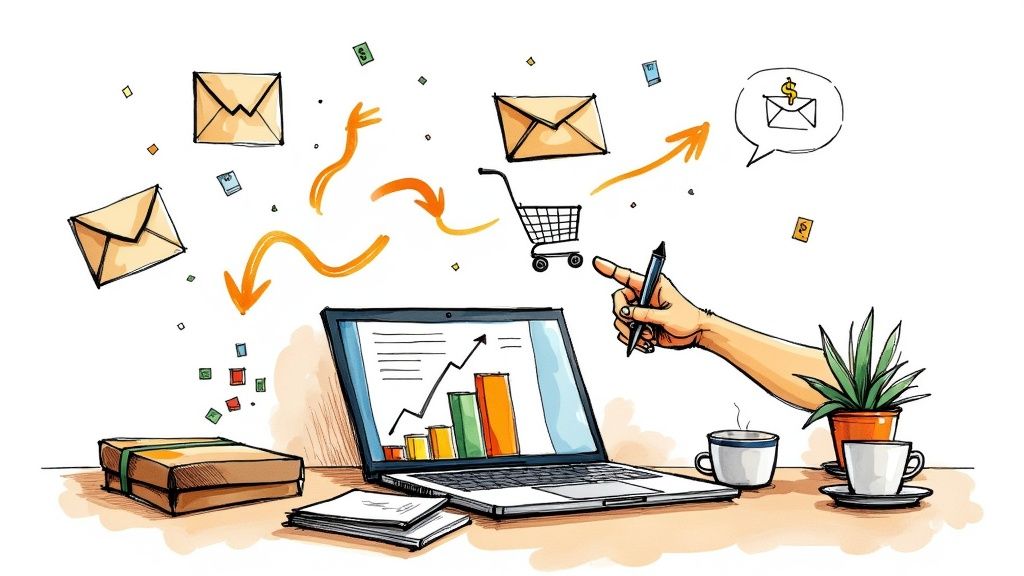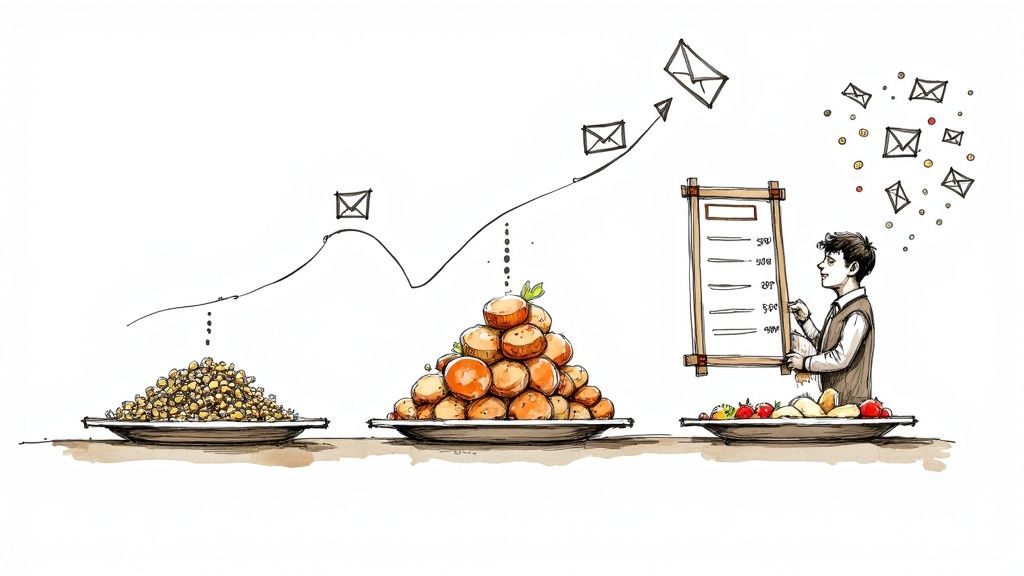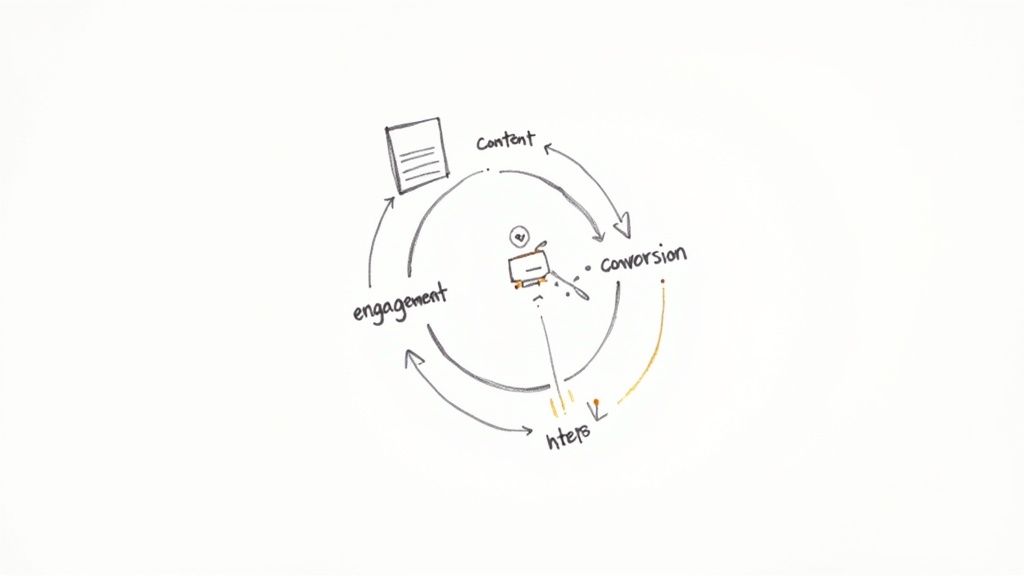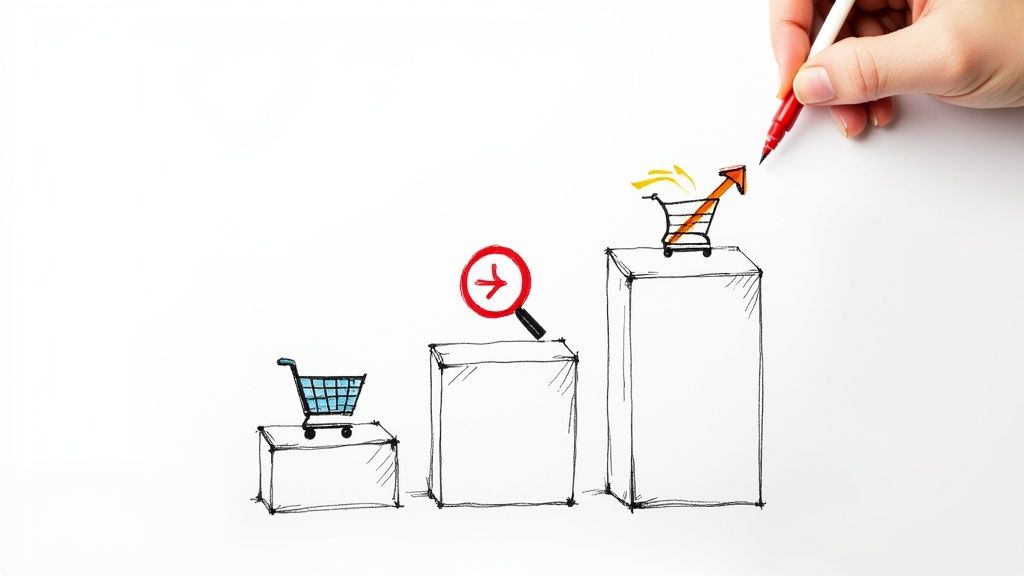Content Strategy for Ecommerce: Proven Tactics to Boost Sales

14 mins
6/12/2025
Joe Ervin
- content strategy for ecommerce
- ecommerce content marketing
- ecommerce SEO strategy
- online store marketing
- ecommerce conversion
Building Your Ecommerce Content Foundation That Actually Works

Let's be straight: a lot of online stores just create content and fling it out there, hoping it sticks. It's a bit like throwing spaghetti at the wall – maybe some of it will stick, but it's not exactly a recipe for success. A truly effective ecommerce content strategy? It's about building a rock-solid foundation. That means understanding your customer inside and out – what they search for, what their pain points are, and what language truly resonates with them, not just churning out random blog posts and product descriptions.
I've seen firsthand how so many businesses just scratch the surface when it comes to customer research. Sure, knowing demographics is important, but it's only the first step. The truly profitable stores? They dig deeper. They want to understand the why behind the buy. What truly motivates their customers? What are their anxieties? What are they thinking about when they can't sleep at night? These are the insights that become the bedrock of a truly effective ecommerce content strategy.
Let's say you sell organic baby food. Knowing your audience is parents of young children – well, that's a no-brainer. But what if your research uncovers a large segment worried about hidden sugars in most baby food? Bingo. That unlocks a treasure trove of content ideas. Blog posts about the dangers of added sugar, highlighting your product's sugar-free benefits, even recipes using your baby food as a healthy ingredient. You’re speaking directly to their concerns, positioning yourself as the trusted expert.
And this is where understanding customer language becomes so crucial. Don't guess - know what words they use. Dive into customer reviews, social media comments, and online forums. What phrases or words keep popping up? Those are the exact words you need to weave into your product descriptions and content. This isn't just about SEO – it's about connecting with your customers on a deeper level, building that all-important trust. Over the past ten years, I've seen ecommerce content strategies really mature, incorporating so many more digital and data-driven approaches. By 2025, it's not even a question – leveraging data-driven content is essential if you want to build trust and create those valuable, long-term relationships. Deeply understanding your audience informs everything – what you create, how you create it, and where you share it. It ensures your content truly resonates. Discover more insights on ecommerce marketing trends. Finally, take a long, hard look at what you've already created. What's working? What's falling flat? This honest assessment helps you refine your strategy and double down on what’s actually driving traffic and conversions. It’s about maximizing impact, not just creating content for the sake of it.
Creating Content That Guides Customers From Browse to Buy

So, you’ve laid the groundwork for your ecommerce content strategy. Great! But now comes the real challenge: how do you craft content that actually works? Content that effortlessly ushers customers from casually browsing to confidently clicking that "buy now" button? It's all about understanding their journey. Too many online stores just throw random content out there without a thought to where their customer is in the buying process.
Think of it like planning a hike. You wouldn’t drop a beginner hiker at the base of Everest and expect them to summit. You'd guide them, step by step, along a manageable path. Your content should do the same.
Mapping Your Content to the Customer Journey
Let’s break down the customer's mental state at each stage. Early on, when someone is just realizing they have a problem, they’re not looking for a sales pitch. They’re searching for information, answers, solutions. This is where educational content comes in.
For example, let's say you sell specialty teas. A customer searching "how to make the perfect cup of tea" is just starting their journey. A blog post about different steeping techniques, complete with beautiful imagery subtly showcasing your unique tea blends, is a perfect entry point. Not a hard sell, just helpful advice.
Once customers understand their problem and start exploring solutions, things change. They’re comparing different options, reading reviews, and figuring out which brands they can trust. This is where your content needs to build credibility. Think customer testimonials, maybe a detailed comparison of different tea types, or even a behind-the-scenes peek at your ethical sourcing practices. Show them you're the real deal. Don't just tell them.
Finally, when a customer is on the verge of buying, they often just need that last little nudge. This is where persuasive content shines. Highlight the unique benefits of your teas, address any last-minute concerns, and make that "add to cart" click irresistible. Think limited-time promotions, free shipping offers, or a compelling email series demonstrating how your teas can elevate their daily ritual.
To help visualize this, I’ve put together a handy framework. It’s something I use all the time to map my content.
To illustrate this concept effectively, consider the following table:
| Journey Stage | Customer Mindset | Content Types | Primary Goals | Success Metrics |
|---|---|---|---|---|
| Awareness | Problem Recognition | Blog posts, educational videos, infographics | Drive traffic, generate leads | Website visits, social media engagement |
| Consideration | Solution Exploration | Product comparisons, customer testimonials, case studies | Build trust, position product | Time on page, lead magnet downloads |
| Decision | Purchase Readiness | Product demos, special offers, free shipping | Convert leads into customers | Conversion rates, sales |
| Post-Purchase | Customer Retention | Follow-up emails, loyalty programs, exclusive content | Build loyalty, encourage repeat purchases | Customer lifetime value, repeat purchase rate |
This table, the "Customer Journey Content Mapping Framework," offers a structured way to align your content with the evolving needs of your customer throughout their buying process.
By tailoring your content to each stage, you create a seamless, guided experience that nurtures leads and ultimately drives sales. Remember, each piece of content should have a clear purpose: moving the customer one step closer to purchasing from you.
Content Formats That Actually Convert Browsers Into Buyers
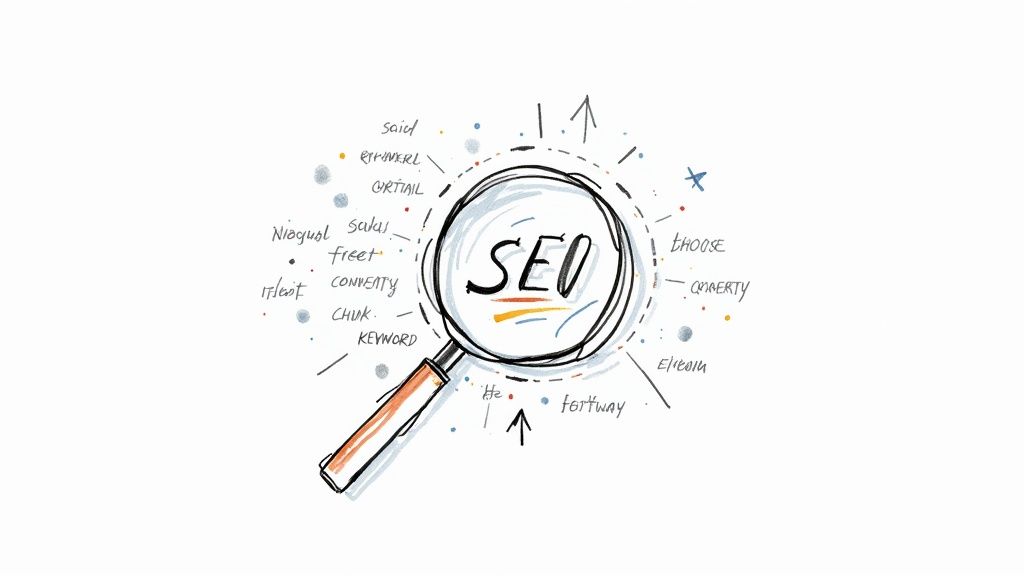
We've talked about mapping content to the customer journey, but what content really moves the needle? This is where picking the right format becomes essential to your ecommerce content strategy. Forget generic blog posts and dull product descriptions—those just don't resonate. Successful ecommerce businesses know different content formats connect differently with customers at various buying stages.
One effective method? Storytelling. Instead of just listing features, create a narrative around your products. Show how they solve problems and improve lives. Make the ordinary feel extraordinary. Think about how a luxury skincare brand might sell the feeling of confidence, not just a face cream. That’s way more compelling than a list of ingredients.
Then there’s the magic of user-generated content (UGC). Authentic reviews and real customer experiences build trust like nothing else. Encourage customers to share their stories and show how they use your products. Feature them on your website and social media. Think about how fashion brands use Instagram by reposting customer photos – it's like word-of-mouth marketing amplified.
Educational Content and Product Descriptions That Sell
Beyond storytelling and UGC, educational content changes the game. Creating informative blog posts, videos, or even downloadable guides positions you as an expert. This builds credibility and attracts customers actively looking for solutions. A store selling hiking gear, for instance, could write a blog post about gear for beginners, naturally weaving in its product offerings within the helpful advice. For a deeper look into ecommerce content strategy, check out this helpful resource: a deeper dive on ecommerce content strategy.
Even product descriptions, something often overlooked, can be powerful conversion tools. Instead of generic blurbs, focus on addressing customer concerns and highlighting unique benefits. Use clear, concise language, avoiding jargon. If you sell organic coffee, don't just say “smooth and delicious.” Describe the sustainable farming, the rich aroma, and the ethical sourcing that make your coffee special.
Video Content and the Power of Customer Stories
Video content is another game-changer for your ecommerce content strategy. Even small businesses can create compelling videos that showcase products in action, offer tutorials, or share testimonials. Think unboxing videos, product demos, or behind-the-scenes looks at your business. These personal touches resonate with customers.
Finally, never underestimate the power of in-depth customer stories. Go beyond basic testimonials and dig into individual customer experiences. Show how your products have truly made a difference. Authenticity is key here. Don’t go for overly polished or inauthentic stories. Keep it real! Let your customers’ genuine excitement shine through. This balance of helpfulness and promotion keeps customers engaged without feeling bombarded by constant sales pitches.
Smart Technology That Scales Your Content Without Losing Soul

These days, a solid ecommerce content strategy isn't just about pumping out product descriptions and blog posts. Savvy online stores are using technology to seriously boost their content game while keeping that all-important human touch. Think of it as having a really good assistant who handles the boring stuff, freeing you up for the creative, strategic work that connects with your audience.
Content automation is a prime example of where technology can shine. Tools like Hootsuite for social media scheduling, Klaviyo for personalized emails, and even AI-powered product description generators can be real game-changers. But here’s the thing: automation should support human creativity, not replace it. I've seen too many businesses go overboard with automation, ending up with generic content that completely misses the mark. The sweet spot is using tech for the repetitive tasks while keeping a human eye on the overall strategy and brand voice.
AI Tools for Ecommerce Content
AI-powered tools are playing an increasingly important role in ecommerce content strategy. These tools can analyze customer data to spot trends, personalize product recommendations, and even generate content ideas based on what's already working. This means you can create experiences that feel truly relevant by tailoring your message to specific customer segments. For instance, imagine using AI to analyze past purchases and then sending targeted emails showcasing complementary products or offering personalized discounts. That kind of personalized touch can make a big difference in your conversion rates.
The world of AI can be a bit overwhelming, though. With so much buzz, it's tough to know which tools are actually worth the investment. My advice? Start small and focus on tools that solve your specific problems. If writing product descriptions is a bottleneck, check out AI copywriting tools like Jasper. If you want to personalize your email marketing, look into platforms that offer AI-driven segmentation and automation like Sailthru. This targeted approach makes sure you're getting the most out of your budget. The use of AI in B2C, including ecommerce, is predicted to more than double between 2023 and 2025. Email marketing is still a major influencer, with 59% of B2C consumers saying it impacts their buying decisions. Discover more insights on these trends.
Chatbots and Analytics for Enhanced Customer Experience
Chatbots are another powerful tool. Done well, they can provide instant support, answer FAQs, and even guide customers through the purchase process. The key is to make them helpful, not annoying. Avoid overly complicated scripts and make sure a human can step in when needed. This mix of automation and human interaction is ideal.
Finally, don't forget about analytics. Data-driven insights are crucial for understanding what content resonates with your audience, drives conversions, and ultimately impacts your bottom line. Use platforms like Google Analytics to track website traffic, social media engagement, and email open rates. This data gives you valuable clues about what's working, what's not, and where you should focus your content efforts. Analyzing customer behavior helps you continuously refine your content strategy, making sure you’re always delivering the right message at the right time. It’s about using data to inform decisions, not just track vanity metrics.
To help you build your content technology stack, I've put together a comparison of some essential tools. It covers different aspects of content strategy, including features, pricing, and best use cases.
| Tool Category | Recommended Tools | Key Features | Pricing Range | Best For |
|---|---|---|---|---|
| Social Media Management | Hootsuite, Buffer | Scheduling, analytics, engagement | $29-$739/month | Managing multiple social media accounts |
| Email Marketing | Klaviyo, Mailchimp | Automation, segmentation, personalization | Free-$399+/month | Targeted email campaigns |
| SEO & Content Optimization | Semrush, Ahrefs | Keyword research, competitor analysis, site audit | $119-$999/month | Improving search engine rankings |
| Content Creation | Jasper, Copy.ai | AI-powered writing assistance | $29-$499/month | Generating various types of content |
| Analytics | Google Analytics, Adobe Analytics | Website traffic analysis, user behavior tracking | Free-$500+/month | Measuring content performance |
| Chatbots | Intercom, Drift | Live chat, automated responses, customer support | $74-$2,400+/month | Enhancing customer service |
This table provides a starting point. The best tools for your business will depend on your specific needs and budget. Remember to do your research and choose the tools that fit your content strategy best.
Getting Your Content In Front of People Ready to Buy
Creating amazing content is like baking an incredible cake. It might look and smell fantastic, but it doesn't do much good unless someone actually eats it! A solid ecommerce content strategy isn't just about the creation part – it’s about getting that content to the right people, at the right time. This means knowing where your audience hangs out online and tailoring your distribution strategy to fit. It's all about strategic thinking, not just throwing your content out there and hoping for the best.
Search Engine Optimization (SEO) for Ecommerce
One of the most reliable ways to connect with potential customers is through search engine optimization (SEO). This is about optimizing your content so it shows up high in search results when people look for products or information related to your business. Forget keyword stuffing or shady SEO tricks – real SEO is about understanding what your customers are actually searching for and creating content that provides real value and answers their questions. Take a look at this screenshot from the Wikipedia page on SEO. It sums up key elements like keyword research, on-page optimization, and link building.
As you can see, SEO is complex, involving both technical know-how and creative content strategies. It's definitely a marathon, not a sprint, demanding consistent effort, but the payoff in organic traffic and brand visibility can be incredible.
Want to learn more about mapping your content to the customer journey? I've got you covered: Check out our guide on the ecommerce customer journey.
Social Media Marketing for Ecommerce
Besides SEO, social media is another powerful tool for sharing your ecommerce content. But just posting randomly won't cut it. You need to understand which platforms your target audience prefers and create content specifically for those platforms. Selling high-end fashion? Instagram might be your best bet. Targeting a B2B audience? LinkedIn could be more effective. The key is to be strategic. Don't just post and ghost—engage with your followers, respond to comments, and build a real community around your brand.
Email Marketing for Ecommerce
Let's not forget about email marketing – a crucial piece of the distribution puzzle. Building an email list helps you nurture leads, promote new products, and stay top-of-mind with current customers. No one wants spam, so make sure you’re providing real value, personalizing your messages, and segmenting your audience based on their interests and past purchases. This lets you send targeted emails that feel relevant and helpful, not annoying.
Partnerships and Influencer Marketing
Think outside the box with partnerships and influencer collaborations. Teaming up with related businesses or influencers can introduce your brand to a completely new audience. For example, if you sell handmade baby clothes, partnering with a local parenting group or a baby photographer could be mutually beneficial. Make sure the partnership fits your brand and target audience. Focus on collaborations that provide measurable results, not just vanity metrics.
Repurposing Content for Maximum Reach
Finally, repurposing content is a great way to get more mileage out of your best work. Turn a popular blog post into several social media posts, an infographic, or even a quick video. This saves you time and effort while getting your message in front of a larger audience. It's about working smarter, not harder. By thinking strategically about content distribution, you can transform your amazing content into a powerful tool for driving traffic, building brand awareness, and ultimately increasing sales.
Tracking What Actually Matters for Your Bottom Line
So, you've poured your heart into your content strategy, crafting engaging pieces you're truly proud of. But are those pieces actually bringing home the bacon? Many ecommerce stores fall into the trap of vanity metrics: likes, shares, and page views. These numbers might look good on a report, but they don’t always translate into cold, hard cash. Let's ditch the fluff and dive into the metrics that truly affect your profits.
Setting up proper tracking systems is key. You need to see what content actually leads to purchases, not just window shoppers. Imagine your online store is a bakery: tons of people might admire your beautiful cakes, but if no one’s buying, you're not making any money. You've got to find the holes in your sales funnel.
Identifying High-Converting Content and Calculating ROI
Tools like enhanced ecommerce in Google Analytics reveal the entire customer journey. You can see precisely which blog posts or product descriptions lead to add-to-carts and purchases. This helps you understand what your audience loves and what content is just gathering dust. Then, you can calculate the true ROI of your content marketing efforts – the actual profit it generates.
I once worked with a clothing boutique obsessed with Instagram followers. They had thousands, but sales were flat. Analytics revealed their Instagram traffic barely reached their website, let alone converted into sales. We pivoted to shoppable posts and Instagram Stories that sent traffic directly to product pages. This small tweak significantly boosted their sales.
Advanced Analytics and A/B Testing
Beyond basic tracking, advanced analytics takes it a step further. Consider metrics like customer lifetime value, average order value, and even the specific products bought after engaging with certain content. This granular data offers valuable insights into repeat business drivers and how to optimize for maximum profit.
A/B testing is another game-changer. Experiment with different headlines, calls to action, or even image placements on product pages. The results might surprise you. I've seen tiny changes, like button color or headline tweaks, dramatically increase conversion rates.
Customer Feedback and Reporting Systems
Don’t ignore customer feedback. Surveys, reviews, and social media comments are goldmines of information. They tell you what customers want, what they adore, and what they dislike. Use this feedback to sharpen your content strategy and create even more targeted material.
Finally, build simple reporting systems. You don't need complex dashboards. A few key metrics, presented clearly and regularly, help you make smart decisions about where to invest your time and resources. Knowing which content efforts are paying off allows you to double down on the winners and ditch the losers. It’s about using data to steer your strategy and ensure your content always works for you.
Your Practical Roadmap to Content Strategy Success
So, we've talked concepts. Now let's roll up our sleeves and get practical. How do you actually make this happen? Forget the abstract – this is about a real-world ecommerce content strategy you can implement this week. Consider this your 90-day roadmap, designed to guide you through the initial stages, even with limited budget and time.
Your First 30 Days: Laying the Groundwork
The first month is all about understanding your customer. Remember that deep dive we discussed? Time to put it into action. Define your ideal customer profile, really dig into their pain points, and understand what language truly speaks to them. This is the bedrock of your strategy, so don’t cut corners! While you're at it, audit your existing content. What’s working? What’s not? This helps identify quick wins and areas you can improve. Start small, focusing on optimizing your highest performing content first.
Days 30-60: Creating and Refining Content
Once you have a handle on your customer and your content landscape, start creating fresh content that addresses gaps in your customer journey. Think about formats that convert: strong product descriptions, engaging blog posts, maybe even short, impactful videos. Prioritize quality over quantity. A few well-crafted pieces are significantly more effective than a mountain of mediocre content. Begin optimizing your most important product pages for search, using the customer language you've identified. Even minor adjustments can make a big difference. Looking to scale your ecommerce business? Check out this guide: Scaling Your Ecommerce Business: A Practical Guide.
Days 60-90: Getting Your Content Out There and Measuring Results
This final phase is about getting your content in front of the right eyes. Concentrate on distribution channels relevant to your specific audience. Is it SEO? Social media platforms like Facebook or Twitter? Email marketing? Don’t spread yourself too thin. Pick one or two channels and master them. Lastly, set up tracking systems to measure the important things. Focus on metrics that directly affect your bottom line: conversions, sales, and customer lifetime value. This data will fine-tune your strategy, ensuring your content continues to produce results. Remember, a successful ecommerce content strategy is a living thing, constantly evolving and adapting to your customers and the market.
